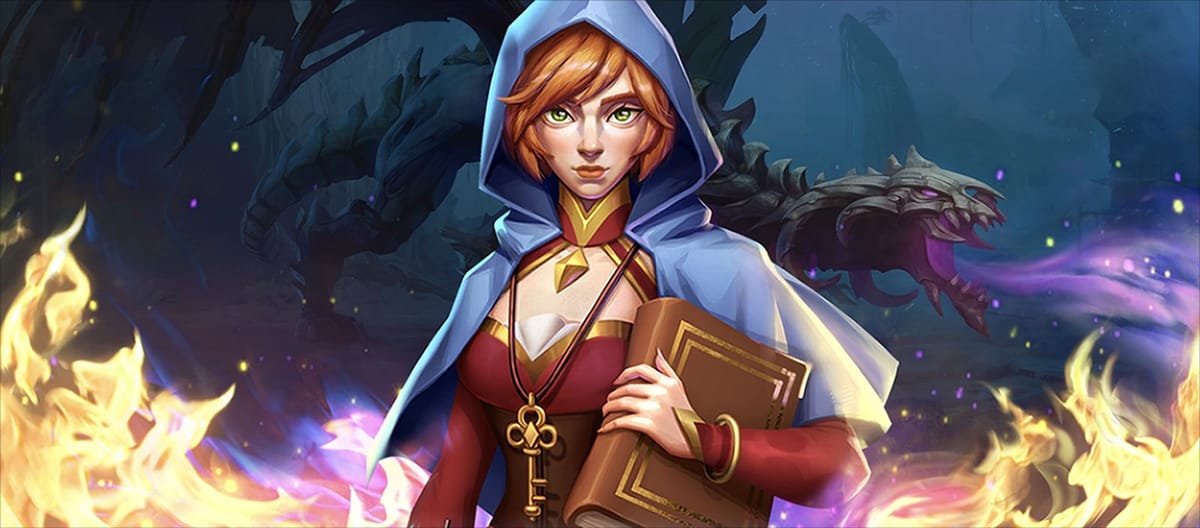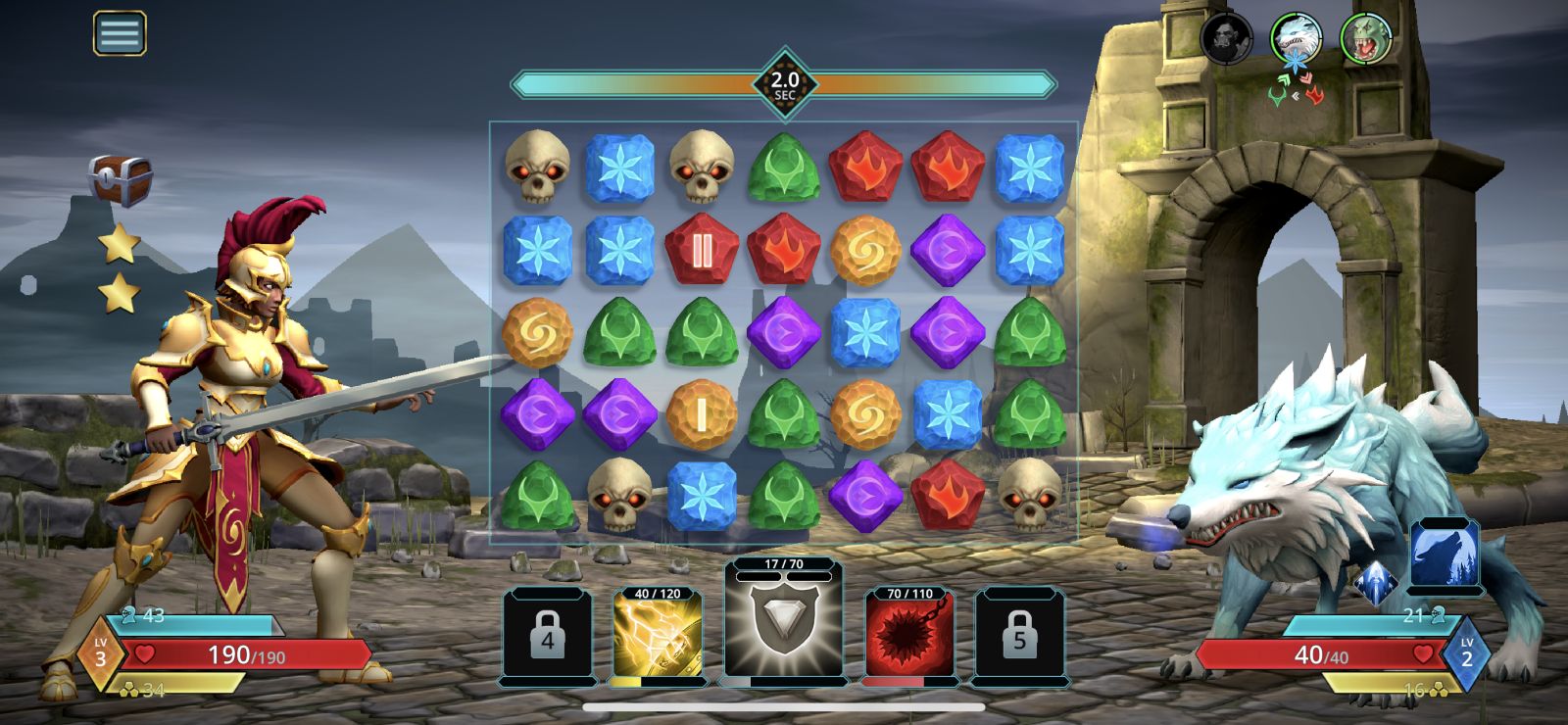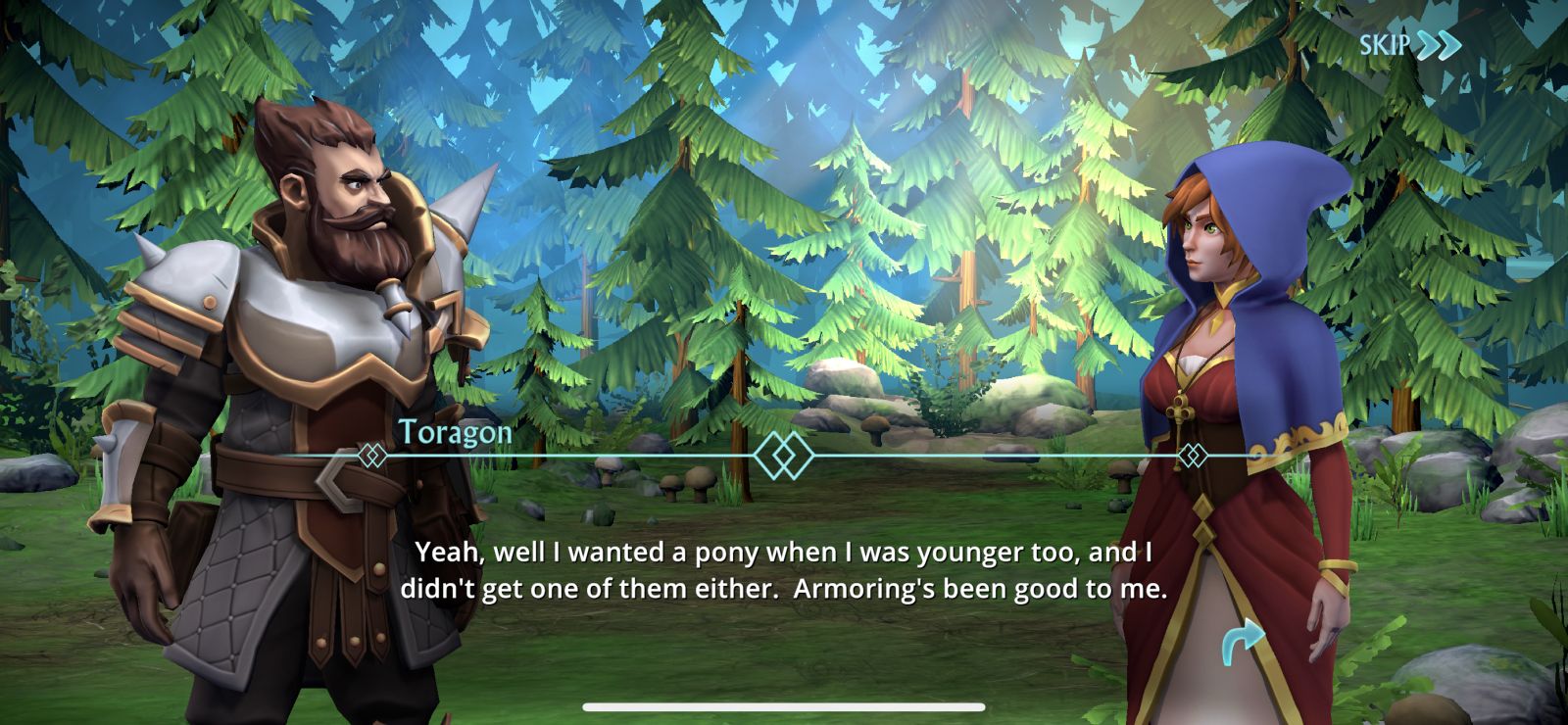
Dragons haven’t been seen in years, thought to be wiped out after the last great war between dragons and the younger races, but now there’s talk of villages burning and a prophecy that threatens to throw the world back into chaos. In Puzzle Quest 3, a new turn-based match-3 puzzle combat adventure, you play as an unnamed hero who will face this threat head-on with the help of their allies and some quick matching on your part. Another action packed adventure that fits in your pocket, Puzzle Quest 3 is sure to be a delight for puzzle and adventure enthusiasts.
Upon starting the game you’ll choose between five different classes; the assassin excels at disabling enemies before landing a final decisive strike; the berserker can enter into a ferocious rage where every strike becomes deadly; become the necromancer to master both cold and death magic; become a shaman if you would prefer poison and healing; lastly, the paladin, the honorable knight, which is the class I chose. Each class comes with their own special skill and perks so you can play the game however you prefer. You will then equip gear and spells along your journey to gain stronger attacks, increase your defenses, and more. Gear and spells come in different rarities that can grant you bonuses, such as strength, to aid you in combat, and if you have stuff you aren’t using, you can salvage it to get more materials to keep leveling up what you keep.
One thing I found interesting was that the rarities of your gear and spells can be increased just by leveling them up. At level 5, for instance, you are able to upgrade from common to uncommon, which further increases effectiveness and bonuses. But I did find that once I had started leveling up and increasing the rarity of what I already had, new gear and spells I got down the line ended up unused I did find a couple things here and there that I decided to switch out, but for the most part, anything new I received did end up getting salvaged to upgrade what I already had.
As I said before, this is a match-3 puzzle combat game – you make matches of 3 or more gems of the same color – but what sets this one apart from similar games like Puzzles & Empires and Candy Crush, is that you are able to make multiple matches per turn. You are given an initial timer of 2 seconds to make your matches before you actually make your attack. Every match you make increases the timer slightly allowing you to make more and more matches until the timer runs out or you run out of available matches. Matches can be made via the standard horizontal and vertical movements, but you are also able to make diagonal moves as well. Every match you make fills up meters of corresponding spells and special abilities that are lined up at the bottom of the screen. Once the meter fills, you are able to unleash a devastating attack, get a buff, or get some of your health back.
I found this style of match-3 to be a ton of fun to play as it allowed me to get creative with my attacks and to also plan ahead for follow up moves. If I noticed I was getting low on health, I would start matching up my blue gems to fill up the meter for my health regeneration spell as well as my yellow gems to get back some of my resistance. But after playing for hours, I did sometimes start falling to what I refer to as match-3 blindness, when I would start struggling to find matches to make even if they were painfully obvious and I would realize too late my error, causing me to take more damage and possibly even lose the fight. However not all is lost if your health does manage to drop all the way down to 0. You have the chance during every combat sequence to pay 50 gems to be revived with full health to continue the fight, but only once, so make sure you pay attention and keep your health up.
The game consists of 15 chapters divided into 10 parts each. Between combat sequences your character enters into dialogue with allies and others you meet on the road which is where your story develops. For the most part, the story is fully set in stone, but there are some points within the dialogue where you get to choose how your character responds. I haven’t seen this necessarily have any sort of effect on how the story progresses, but that can be determined in later replays to see if anything changes. After each combat sequence you are sent back to the main screen of the game where you can make any upgrades available to you as well as embark on side missions with your followers and so much more.
You are awarded a chest of varying value depending on how many moves you make during a fight. Chests can be opened either with keys, gems, or minions. Chests can contain any number of things of varying rarities and usefulnesses depending on the chest (wood, iron, gold, or ruby chests). Sometimes you get gear, spells, and more minions from opening a chest. Each chest also has a small chance to get a bonus key back as well. Be mindful though, because keys and gems are limited. Minions are also on a timer, so you can’t open the chest with a minion until their timer is up, and then the minion needs to rest before being used again. If all else fails, you are also able to salvage the chest, but you don’t get as much back if you do. I found this to be a little tedious because you also have a limit to how many chests you can have waiting to be opened, a max of 5, so if you are all out of gems or keys and your chest slots are full you are stuck resorting to salvaging the chest.
You recruit 15 allies, called followers, throughout the game, each one having a special bonus or something they provide. One of your first followers is Toragon who can craft you a random piece of armor that you can either equip or salvage. Other followers might give you resource bonuses or help with inventory space and so much more. Your followers are also able to be leveled up and have their rarities increased to further increase their usefulness. You are also able to go on side missions with each of these followers to learn more about them while also getting some much needed loot to help you get stronger for the main story. The only gripe I have about this is right away some of the side missions felt like a grind on their own as I often found myself not having a high enough gear score to go up against the enemies I would have to face. As something to do to help you get stronger for the main mission, I would have expected these side missions to be a little more approachable.
The game does feature your typical in-game networking options. You can choose to join or start a new kingdom (like a guild or clan) where you can recruit other people to join for special missions and rewards. You are also able to party up with friends outside your kingdom to do dungeons and missions together as well. Right now with the game being very new, this area still seems to be a little bare, but there are already plenty of people online to go up against or to pair up with. If you are in a kingdom, winning a skirmish versus another player rewards your kingdom a number of crests that are able to be redeemed for more resources and other things to help you and your people. There are also other special events and tournaments you can enter into to climb the leaderboards and earn some trophies. It looks like competitive seasons may also be on the horizon as there is a ‘Seasons’ option shown in the ‘World’ tab. On this page you can see all the different things you can do between your main story skirmishes.
As with nearly every other game at this point, the game does have an in-game marketplace where you can spend money to get more gems, more keys, and just more. There are even a couple of different ‘services’ you can purchase. One is a VIP subscription that gives you daily rewards of gems, keys, and other useful items. There is also a Quest Pass which is basically a battle pass system where you unlock tiers by completing challenges. I do feel as if this Pass is a little overpriced, however. Whereas most passes of this kind are about $10, this pass actually is more around $15. Although I am guilty of making these microtransaction purchases in similar games, I can’t say that I am a fan of them as they are often still along the lines of a pay-to-win model. The game does have online features to go up against other players in, so it can easily become a battle of the wallets.
Overall, I have loved Puzzle Quest 3. The game is very well done, plays very smoothly, and looks awesome. The level of detail given to the different characters, the monsters, the menus, and everything in between, must be remarked on as it is very impressive. The game is easy to learn and to master, there’s no steep learning curve, I feel it is accessible to everyone. It is also very easy to navigate, you don’t have to go far to find what you are looking for as everything is well organized. The story and characters are so much fun to explore, this game makes a fine addition to my collection.
Puzzle Quest 3
Great
Puzzle Quest 3 is an excellent addition to the match-3 puzzle combat adventure genre. The game is easy to pick up and plays smoothly. With an intriguing story and amazing cast of characters, it's sure to be a hit for people across the board.
Pros
- Beautiful, intriguing medieval fantasy story
- Very well organized and designed
- No steep learning curve, very smooth gameplay
- Pegasus
Cons
- Once early gear starts getting upgraded, new gear seems useless
- Marketplace seems a little overpriced
- Pay-to-win model-ish
- Giant Spiders


